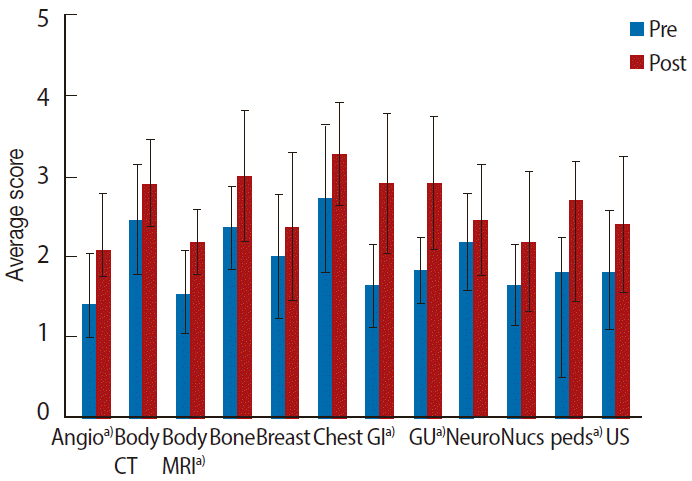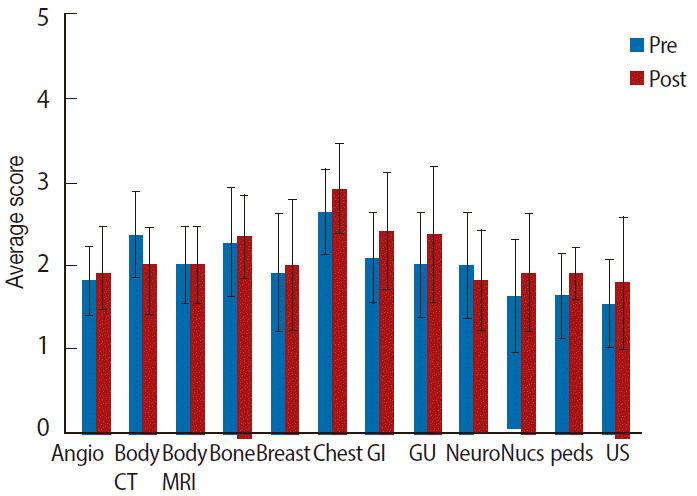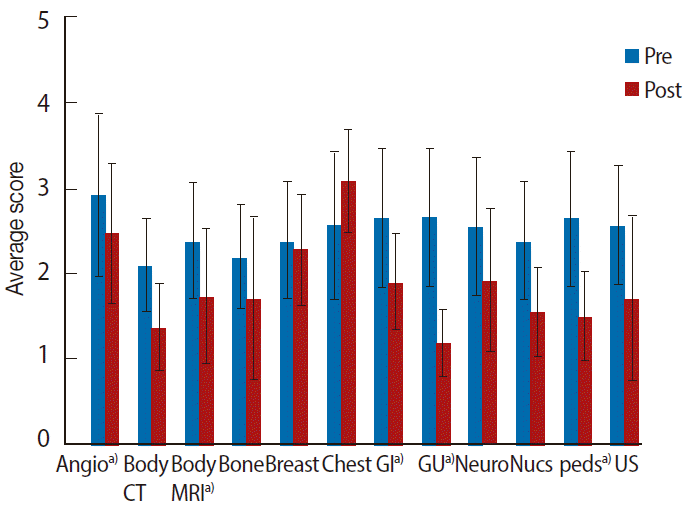This article has been
cited by other articles in ScienceCentral.
Abstract
Incoming radiology residents must rapidly assimilate large amounts of technical, medical, and operational information. This can be overwhelming and contribute to anxiety. Typical introductory curricula focused on radiologic content may not address the concerns of new residents. Two consecutive classes of incoming radiology residents participated in our study. For groups A (n=11) and B (n=11), the existing introductory lectures were given by faculty. For group B, residents hosted sessions for each rotation, including round-table discussions and work area tours, with emphasis on resident roles, personnel, and workflow. With institutional review board exemption, residents were anonymously surveyed before and after the sessions regarding: awareness of responsibilities, familiarity with anatomy, and anxiety regarding each rotation on a 1-4 scale. Free-text comments were collected. Comparison was performed using Wilcoxon rank sum test. Group A reported increased role awareness (P=0.04), greater content familiarity (P<0.05), and decreased anxiety (P=0.02) in one rotation each. There were 3 of 12 rotations in group B that showed significantly increased role awareness (P range <0.01 to 0.01) and decreased anxiety (P range <0.01 to <0.05). In addition, two rotations indicated improved role awareness only (P=0.02 and P=0.04), while there were four rotations reported decreased anxiety only (P range 0.01 to 0.03). Free-text commenters preferred the resident-run portions of the sessions. In conclusion, adding role-oriented introductory sessions to existing lectures for first-year residents decreased anxiety and increased role awareness for all rotations; therefore, it is suggested that anxiety may be better addressed by role-oriented content, and resident-to-resident teaching may have benefits.
Go to :

Keywords: Anxiety, Curriculum, Radiology, Rotation, Workflow
Starting a new residency program is daunting. Each year, interns in every type of program assume their responsibilities while knowing relatively little about their fields. Although interns in medicine, pediatrics, or surgery have probably rotated for several months in these areas as medical students, they understandably lack confidence in their abilities; indeed, a national survey of 4,136 surgery residents showed that those residents in lower post-graduate years had less self-reported confidence in their operating skills [
1]. To make matters worse, first-year residents in radiology have essentially no first-hand experience and must rapidly assimilate a large amount of technical, anatomic, pathologic, and operational information to which they have had little or no exposure. This can be overwhelming and contribute to anxiety and performance problems. Despite the universal challenges of adjusting to residency, little in the literature suggests how to combat this problem. Several groups have developed introductory lectures or sessions to help new residents. Ganguli et al. [
2] developed a one-month, dedicated emergency radiology lecture series to prepare first-year radiology residents for taking independent call. A surgical residency program developed a series of fifteen mock clinical scenarios for interns, and the experience gave interns a significant increase in self-reported confidence [
3]. Along similar lines, a different surgical residency program created an expanded orientation curriculum for their interns, which included small group discussions, lectures, and clinical scenarios [
4]. Senior residents moderated many of these sessions. Despite the interns’ considerable anxiety beforehand, their confidence levels significantly increased both immediately and one month following the intervention.
First-year radiology residents at our institution frequently experience difficulty adjusting to their rotations. After three days of technical orientation such as a picture archiving and communication system training, the incoming residents start their rotations with no formal radiology education. In past years, faculty members have offered a short introductory lecture series during the first two months of the year, consisting of 45-minute talks covering first-year rotations. Lecture content was of faculty choosing; most lectures focused on medical content, but topics varied from search patterns to basic anatomy and pathology to logistical information. The first-year residents have consistently given feedback suggesting that this introductory lecture series was inadequate, expressing a desire for practical information about how to approach their rotations. The purpose of our project was therefore to design, implement, and assess a new ‘role-oriented’ introductory series intended to increase first-year residents’ understanding of their expected participation and responsibilities on their rotations and to decrease their anxiety.
Institutional review board exemption was obtained. Two consecutive classes of first-year radiology residents of the University of Michigan Health System participated (entering in the years 2010 and 2011); informed consent was obtained. Members of both groups, group A (n=11) and group B (n=11), attended the traditional introductory lectures presented by faculty (
Table 1). Due to the addition of an angiography rotation to the first-year curriculum during the intervening year, we added an angiography lecture for group B only (
Table 1). Prior to the lecture series in the second year, we provided new, resident-initiated orientation sessions for each of twelve resident rotations for group B (
Table 1). These sessions corresponded to the original rotations and three additional rotations (angiography, breast imaging, and body magnetic resonance imaging. Orientation sessions lasted approximately 90 minutes and consisted of senior resident-run discussions of rotation expectations and logistics as well as faculty-led tours of the reading rooms, introduction of key personnel, and review of first-year resident workflow. Participants in groups A and B completed anonymous identical surveys before and after the introductory sessions regarding: awareness of their responsibilities and the types of cases seen on the rotation, familiarity with relevant anatomy and pathology, and anxiety level regarding the rotations on a 1-4 Likert scale (1=not at all, 2=somewhat, 3=quite a bit, 4=very much) (
Table 2). Free-text comments were also collected. The pre- and post-survey were conducted anonymously, so it was impossible to match the responses. Therefore, Wilcoxon rank sum test was used to compare the responses between the two surveys. A 5% level of significance was used to evaluate statistical significance in all analyses.
Table 1.
Topics of introductory lecture series and orientation sessions
|
Intro lectures
|
Orientation sessions |
|
Group A |
Group B |
|
Angiography |
|
X |
X |
|
Body computed tomography |
X |
X |
X |
|
Body magnetic resonance imaging |
|
|
X |
|
Bone |
X |
X |
X |
|
Breast imaging |
|
|
X |
|
Chest |
X |
X |
X |
|
Gastrointestinal system |
X |
X |
X |
|
Genitourinary system |
X |
X |
X |
|
Neurology |
X |
X |
X |
|
Nuclear medicine |
X |
X |
X |
|
Pediatrics |
X |
X |
X |
|
Ultrasound |
X |
X |
X |

Table 2.
|
Question no. |
Content |
|
1 |
Are you aware of the kinds of cases you will see and the expectations for your involvement on the service? |
|
2 |
Are you familiar with the basic relevant anatomy and physiology? |
|
3 |
Do you feel anxiety about your role on the service? |

In group A, ten of eleven residents answered the pre-survey and nine of eleven residents answered the post-survey. In group B, eleven of eleven residents answered both the pre- and post-surveys. There was no statistically significant difference between the groups at baseline for any of the outcomes (role awareness, familiarity with anatomy and pathology, and anxiety) regarding any rotation. For group A, role awareness increased somewhat for eleven of twelve rotations and one gastrointestinal (GI) system stayed the same after the lecture series (statistically significant only for chest, P=0.04). Group A’s familiarity with anatomy and physiology increased after the lectures for six rotations (statistically significant only for ultrasound, P<0.05) and stayed the same for four rotations. Group A reported decreased anxiety after the lectures for eight rotations (statistically significant only for nuclear medicine, P=0.02); anxiety increased for two rotations (GI and angiography). For group B, role awareness increased for all rotations, which was statistically significant for five rotations (P range <0.01 to 0.04), while the rest of the rotations positively changed without significance (
Fig. 1). Group B’s familiarity with anatomy and physiology increased for nine rotations, stayed the same for one rotation, and decreased for two rotations (
Fig. 2). None of these changes were statistically significant. Group B reported decreased anxiety in all rotations, which was statistically significant in seven rotations (P range <0.01 to <0.05) (
Fig. 3). Group B’s free text comments indicated a preference for resident-run sessions. One resident mentioned that faculty-led tours led to redundant information. Residents in group B found it helpful to meet some of the support staff with whom they would be working on their rotations and appreciated the practical advice that senior residents offered regarding the rotations.
 | Fig. 1.Group B comparison of awareness of cases and expectations pre- and post-survey. a)Indicate statistical significance (P<0.05). Figure shows average score with standard deviation. CT, computed tomography; MRI, magnetic resonance imaging; GI, gastrointestinal; GU, genitourinary; Neuro, neurology; Nucs, nuclear medicine; Peds, pediatrics; US, ultrasound. 
|
 | Fig. 2.Group B comparison of familiarity with anatomy and physiology pre- and post-Survey. No statistical significance. Figure shows average score with standard deviation. CT, computed tomography; MRI, magnetic resonance imaging; GI, gastrointestinal; GU, genitourinary; Neuro, neurology; Nucs, nuclear medicine; Peds, pediatrics; US, ultrasound. 
|
 | Fig. 3.Group B comparison of anxiety pre- and post-survey. a)Indicate statistical significance (P<0.05). Figure shows average score with standard deviation. CT, computed tomography; MRI, magnetic resonance imaging; GI, gastrointestinal; GU, genitourinary; Neuro, neurology; Nucs, nuclear medicine; Peds, pediatrics; US, ultrasound. 
|
The survey responses showed clear trends and statistically significant changes for a number of categories. Addition of resident-run orientation sessions to the existing introductory lectures increased resident awareness of their responsibilities and decreased their anxiety for all rotations. We conclude that resident-directed discussion about rotation logistics and in-person orientation to the reading room are beneficial for first-year residents. The importance of hands-on or experiential learning in radiology has previously been explored in the area of contrast reaction training. For example, in one recent study, residents who received simulation training reported higher comfort levels and performed better in a mock contrast reaction scenario than their peers who were randomized to a didactic lecture [
5]. Other authors have noted the merits of contrast reaction simulation without directly comparing to didactic curricula [
6]. Although our reading room tours fall somewhat short of true simulation, the effect of this approach is to make the content tangible and relevant to the trainees, removing it from the more abstract domain of the lecture hall.
Free text comments from residents provided feedback about other elements of the intervention that they found helpful. The residents appreciated the chance to meet the support staff with whom they will work. It is crucial for residents to establish good relationships with these co-workers; an early introduction fosters these relationships and underscores an important component of professionalism. In addition, the first-year residents made it clear that they value senior resident involvement, as the seniors have recent experience with the first-years’ situation. A tangential benefit is the opportunity for these senior residents to gain teaching and mentorship experience through their participation.
Residents’ perceptions of their future rotations vary. Group A reported increased anxiety regarding the angiography and GI rotations on the post-survey, in the absence of an introductory lecture for Angiography and despite the lecture for the GI rotation. Some of this anxiety may stem from negative sentiments expressed by senior residents. The prospect of performing complex procedures may also contribute to increased anxiety levels for these particular rotations. After the intervention, however, group B reported decreased anxiety levels in both of these rotations, suggesting that frank discussion makes the rotations more approachable. Surprisingly, group B reported decreased familiarity with anatomy and physiology in the body computed tomography and neuro rotations after the intervention. Why did we see a decrease in self-reported familiarity with this content? It may be that once the residents saw the complicated anatomy and physiology for these rotations, they felt more uncertain about their knowledge. While the orientation sessions are relevant at the beginning of the first year, an expanded introductory lecture series focusing on basic radiology content could be useful as the year progresses.
Among the limitations of the study was the relatively small sample size: only two consecutive classes of eleven residents each completed surveys. Further, in an effort to preserve confidentiality, we did not assign identification numbers, making it impossible to track individual responses. Finally, we had no assessment tool by which to measure actual resident knowledge. Familiarity with anatomy and physiology, therefore, was self-reported and subjective.
Our study demonstrates that anxiety, and by inference, adjustment to radiology residency, may be better addressed by role-oriented introductory content than medically-focused curricula alone. Resident-to-resident teaching likely confers additional benefits in terms of content relevance and resident comfort. Future directions include expanding the introductory lecture series focusing on radiologic content and increasing senior resident involvement.







 PDF
PDF Citation
Citation Print
Print




 XML Download
XML Download